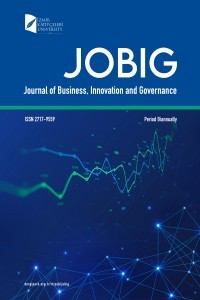EVALUATING TECHNOLOGICAL EMERGENCE FOR STRATEGIC TECHNOLOGY (ETEST) MANAGEMENT: A HYBRID MODEL OF SCIENTOMETRICS AND MCDM APPROACHES
emergence, emerging topics, MCDM, scientometrics, fuzzy
___
- Alexander, J., Chase, J., Newman, N., Porter, A., & Roessner, J. D. (2012). Emergence as a conceptual framework for understanding scientific and technological progress. Picmet '12: Proceedings - Technology Management for Emerging Technologies, 1286-1292.
- Blei, D. M., Ng, A. Y., & Jordan, M. I. (2003). Latent dirichlet allocation. Journal of Machine Learning Research, 3(4-5), 993-1022. doi:DOI 10.1162/jmlr.2003.3.4-5.993
- Chen, C. (2006). Information visualization: Beyond the horizon: Springer Science & Business Media.
- Chen, C. M. (2006). Citespace ii: Detecting and visualizing emerging trends and transient patterns in scientific literature. Journal of the American Society for Information Science and Technology, 57(3), 359-377. doi:10.1002/asi.20317
- Dernis, H., Squicciarini, M., & de Pinho, R. (2016). Detecting the emergence of technologies and the evolution and co-development trajectories in science (detects): A 'burst' analysis-based approach. Journal of Technology Transfer, 41(5), 930-960. doi:10.1007/s10961-015-9449-0
- Ding, W. Y., & Chen, C. M. (2014). Dynamic topic detection and tracking: A comparison of hdp, c-word, and cocitation methods. Journal of the Association for Information Science and Technology, 65(10), 2084-2097. doi:10.1002/asi.23134
- Fuchs, S. (1993). A sociological-theory of scientific change. Social Forces, 71(4), 933-953. doi:Doi 10.2307/2580125
- Garfield, E. (2006). Citation indexes for science. A new dimension in documentation through association of ideas (reprinted from science, vol 122, pg 108-11, 1955). International Journal of Epidemiology, 35(5), 1123-1127. doi:10.1093/ije/dyl189
- Garner, J., Carley, S., Porter, A. L., & Newman, N. C. (2017). Technological emergence indicators using emergence scoring. Paper presented at the Proceedings of PICMET'17: Technology Management for Interconnected World.
- Goldstein, J. (1999). Emergence as a construct: History and issues. Emergence, 1(1), 49-72.
- Guimera, R., & Amaral, L. A. N. (2005). Functional cartography of complex metabolic networks. Nature, 433(7028), 895-900. doi:10.1038/nature03288
- Hofmann, T. (1999). Probabilistic latent semantic analysis. Uncertainty in Artificial Intelligence, Proceedings, 289-296.
- Iwami, S., Mori, J., Sakata, I., & Kajikawa, Y. (2014). Detection method of emerging leading papers using time transition. Scientometrics, 101(2), 1515-1533. doi:10.1007/s11192-014-1380-x
- Khanagha, S., Volberda, H., & Oshri, I. (2017). Customer co-creation and exploration of emerging technologies: The mediating role of managerial attention and initiatives. Long Range Planning, 50(2), 221-242. doi:10.1016/j.lrp.2015.12.019
- Kleinberg, J. (2003). Bursty and hierarchical structure in streams. Data Mining and Knowledge Discovery, 7(4), 373-397. doi:Doi 10.1023/A:1024940629314
- Kontostathis, A., Galitsky, L. M., Pottenger, W. M., Roy, S., & Phelps, D. J. (2004). A survey of emerging trend detection in textual data mining. Survey of Text Mining, 185-224.
- Kuhn, T. (1962). The structure of scientific revolutions. Chicago: University of Chicago Press.
- Li, M., Porter, A. L., & Suominen, A. (2017). Insights into relationships between disruptive technology/innovation and emerging technology: A bibliometric perspective. Technological Forecasting and Social Change. doi:10.1016/j.techfore.2017.09.032
- Nagy, D., Schuessler, J., & Dubinsky, A. (2016). Defining and identifying disruptive innovations. Industrial Marketing Management, 57, 119-126. doi:10.1016/j.indmarman.2015.11.017
- Newman, D. J., & Block, S. (2006). Probabilistic topic decomposition of an eighteenth-century american newspaper. Journal of the American Society for Information Science and Technology, 57(6), 753-767. doi:10.1002/asi.20342
- Pottenger, W. M., & Yang, T. H. (2001). Detecting emerging concepts in textual data mining. Computational Information Retrieval, 89-105.
- Rotolo, D., Hicks, D., & Martin, B. R. (2015). What is an emerging technology? Research Policy, 44(10), 1827-1843. doi:10.1016/j.respol.2015.06.006
- Shibata, N., Kajikawa, Y., Takeda, Y., Sakata, I., & Matsushima, K. (2011). Detecting emerging research fronts in regenerative medicine by the citation network analysis of scientific publications. Technological Forecasting and Social Change, 78(2), 274-282. doi:10.1016/j.techfore.2010.07.006
- Shneider, A. M. (2009). Four stages of a scientific discipline; four types of scientist. Trends in Biochemical Sciences, 34(5), 217-223. doi:10.1016/j.tibs.2009.02.002
- Small, H., Boyack, K. W., & Klavans, R. (2014). Identifying emerging topics in science and technology. Research Policy, 43(8), 1450-1467. doi:10.1016/j.respol.2014.02.005
- Tu, Y. N., & Seng, J. L. (2012). Indices of novelty for emerging topic detection. Information Processing & Management, 48(2), 303-325. doi:10.1016/j.ipm.2011.07.006
- Yayın Aralığı: Yılda 2 Sayı
- Başlangıç: 2018
- Yayıncı: İzmir Katip Çelebi Üniversitesi
SİNİZM: TÜRKİYE’DE SAĞLIK ALANINDA 2011-2018 YILLARI ARASINDAKİ ÇALIŞMALAR ÜZERİNE BİR DEĞERLENDİRME
LEXUS VE ZEYTİN AĞACI: KÜRESELLEŞMENİN GELECEĞİ
Aygülen KARAKUL, Gizem ÖZAYDIN
FİNANSAL RAPORLAMA STANDARTLARI VE UYGULAMALARI BAĞLAMINDA YENİ HESAP PLANI DÜZENLEMELERİ
SOSYAL MEDYA FENOMENLERİ: INSTAGRAM VE KOZMETİK SEKTÖRÜNDE BİR UYGULAMA
ULUSLARARASI TİCARETTE TAHSİL ESASINA DAYALI ÖDEME ŞEKİLLERİ (COLLECTION BASIS) ve UYGULAMA ADIMLARI
RUSYA’NIN YAKIN ÇEVRE POLİTİKASI BAĞLAMINDA AZERBEYCAN-ERMENİSTAN ÇATIŞMASI
ÇİFT-TARAFLI KUYRUK (BEKLEME) SİSTEMLERİNDE OPERASYON YÖNETİMİ
